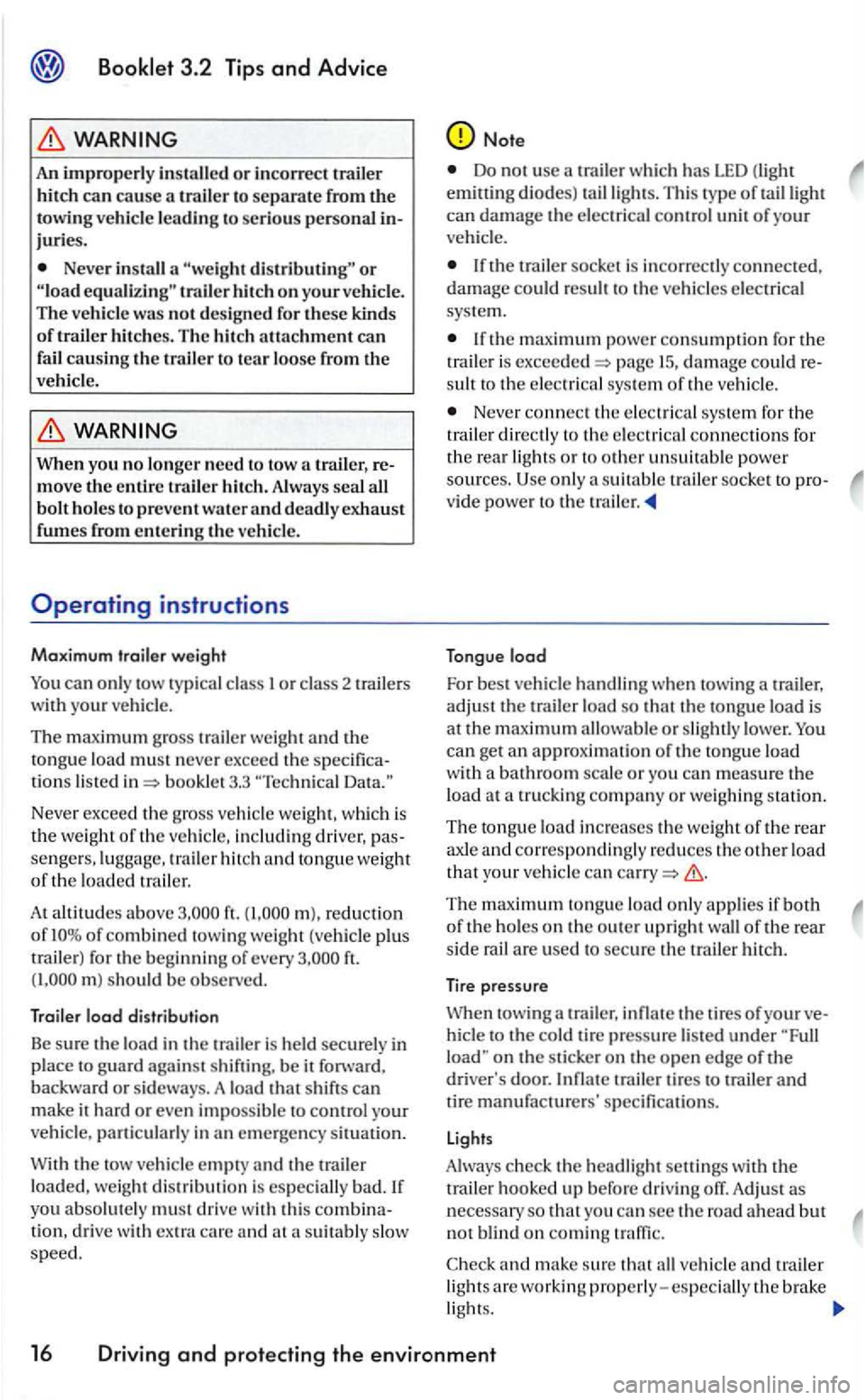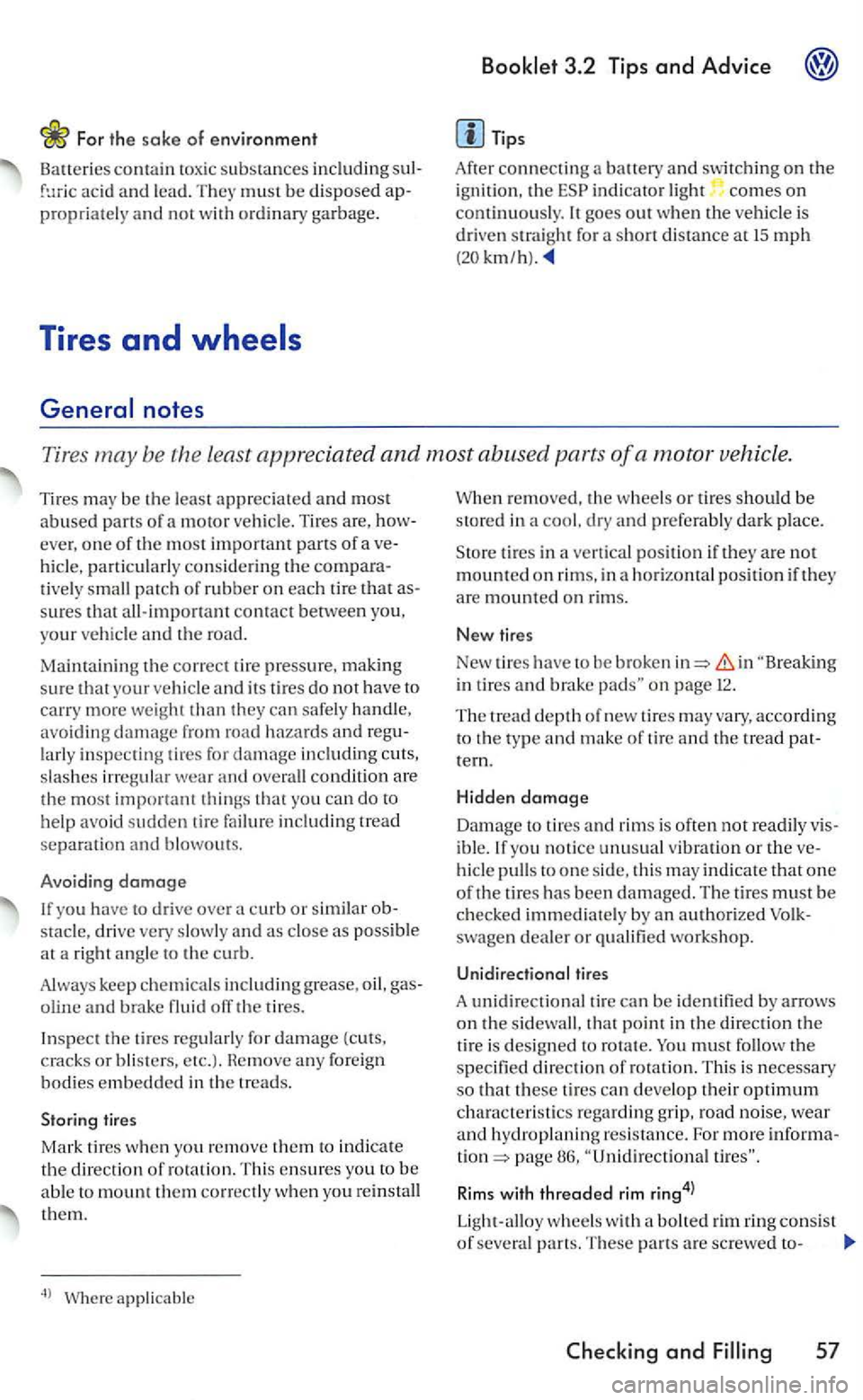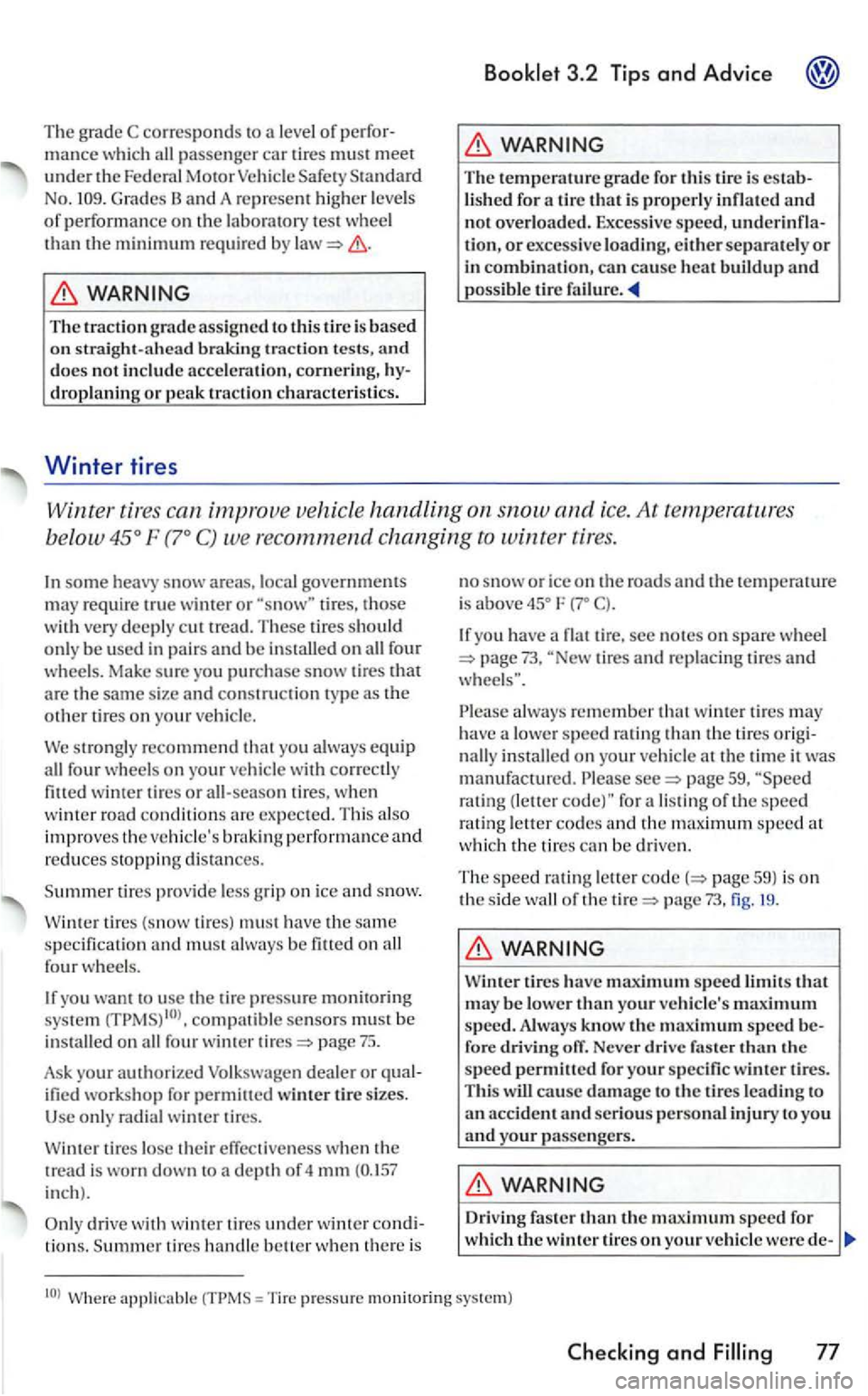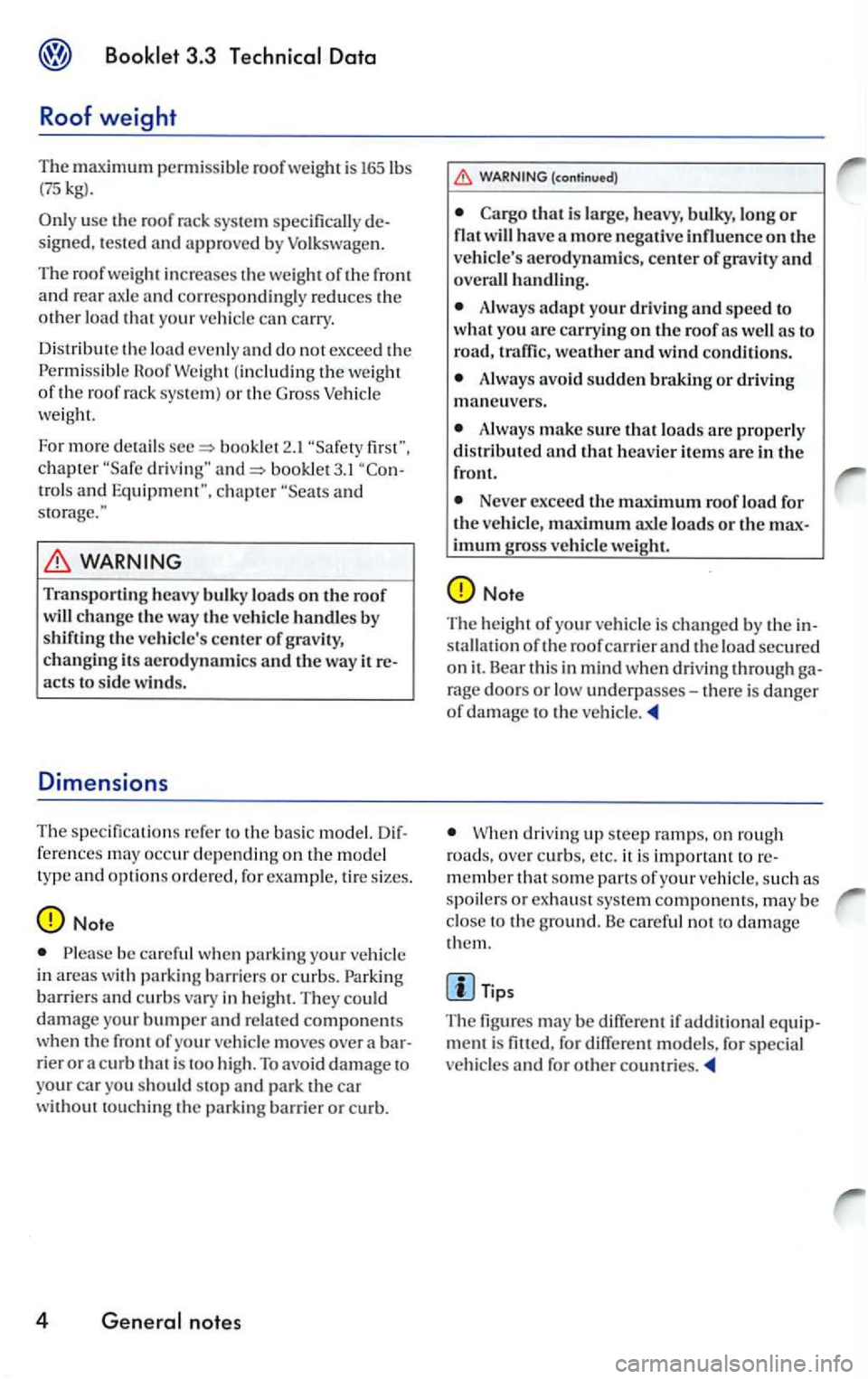tire type VOLKSWAGEN GOLF 2004 Owners Manual
[x] Cancel search | Manufacturer: VOLKSWAGEN, Model Year: 2004, Model line: GOLF, Model: VOLKSWAGEN GOLF 2004Pages: 444, PDF Size: 92.7 MB
Page 292 of 444

An improperly installed or incorrec t hitch from the towi ng vehicle leading to serious personal injuries.
Neve r in stall a on your vehicle . The vehicl e was not designed for these kin ds
o f trailer hitches. The hitch attachment to tear loose from the
ve hicl e.
When you n o longer need t o tow trailer, re
move the trailer hitc h . Alway s seal all bolt holes to prevent water and deadly exhaust fumes entering the ve hicle.
Operating instructions
Maximum trailer weight
You can only tow typical class I or class 2 trailers
with your vehicle.
T he m ax
imum gross trailer we ight and the tongue load must n ever exceed the specifica
tion s listed bookle t3 .3 "Tec hnical
Neve r exceed the gross ve hicl e we ight, w hi ch i s the we ight o f th e vehicle, includin g driver, passenge rs, luggage, trailer hit ch and tongu e we ight of the loaded trailer.
At alt itudes above ft. m), redu ction of of combined towin g weight (ve hicl e plu s trailer) for the beginning of every m ) should be observed.
Trailer l
oad distribution
Be sure the load in the traile r is held securel y in place to guard agains t be it forw ard.
b ackwar d or sideways. A load that shift s can make it hard or even impossibl e to control your vehicl e, parti cularly in an e m erge ncy situ ation.
W ith the tow vehicle empty and the trailer
l oade d , we ight distribution is es pecially bad. If
yo u absolut ely mus t driv e w ith this combina
tion, d rive with extra
Do not use a trailer whic h has LED (light emitting diodes) taillig ht s. This type of t a illi ght can damage the electrical co ntrol unit of your veh icle.
If the traile r socke t is in co rrectly connected .
damage co uld result to the ve hicles electrical
system.
I f th e maximum power consumption for the
trail er is pag e 15, damage could result to the e lectrica l sys te m of th e ve hicle.
Never connect the e lectr ical sys te m for th e
t raile r directly to the electrica l c o nne ctions for the rear lights or to other unsu itable power sources. Use onl y a su itab le trailer soc ket to pro
vide power to the trailer .
Tongue load
For bes t ve hicle ha ndli ng when towing a trail er, adjus t the trailer load so tha t th e tongue load is at the maximum allowable or slightly lower. You can ge t an approx imation of the to ngu e load
with a ba throom scal e or yo u can measure the load at a tru cking company or we ighing station.
The tongu e load incre ases the weigh t of the rear axle and correspondingly reduces the other load that your ve hicle ca n
The max im um tong ue load on ly a ppl ies if both of the ho les o n the o uter upright wall of th e rear side rail are used to secure the trailer hitch.
Tire pressu re
tow ing a trailer, inflate t h e tires of your ve
hicle to the col d tire press ure lis ted under on the sticker o n the open ed ge of the
dri ver's door. Inflate trailer tires to trai ler and tire manufactur ers' specificat ions.
lights
A lw ays check
the headlight settin gs wit h the tr ai le r hooked up before driving off. Adju st as n ecess ary so th a t yo u can see th e road ahead but not blind on coming
C he ck and make sur e th a t all veh icle and trailer lights are workin g properly -especially the brake light s.
16 Driving and protecting the environment
Page 333 of 444

For th e sake of e nvironment
Baueries contain toxi c substances including aci d and lead. must b e disposed propriately and not with ordinary garbage.
Tires and
General notes
Tips
After connecti n g a battery and switching on the ig nit ion, the indicator light comes on continuously. It goes out when the ve hicl e is dri ven straigh t for a short distance at 15 mph km/h ).
Tire s may be the least appreciated and most abused parts of a motor vehicle.
Tires may be the lea st appreciated and most abuse d pa rts of a motor ve hicle. Tire s are, eve r, one of the mos t important parts of
safe ly handle,
avoi din g from road h aza rds and inspecting tires for damage including cuts,
sl ash es irregular wea r you can do to help avoid sudden tire fa ilur e including tread separation and blowouts.
Avo iding
damage
lfyou have to drive over stacle, drive very slowly and as close as poss ibl e
Wher e ap pli cabl e W
h
en removed, the wheels or t ires should be stored in cool. dry and p re ferably dark plac e.
tires in ve rtical position if they are not mounted on rims, in ho rizontal posi tion if they
in " 'B reaking in tire s and brake
type tern.
Hidd
en damoge
Da
mage t o tire s rims is often not readily
swage n dealer or qu alified workshop.
Unidir ection al tires
A unidirectio nal tire can b e idemified by arrows on the sidewall, that p oint in the direction the tire is designed to rota te.
p ag e "Unidirectional
Rims with threaded rim ring4l
Light-allo y wheels w ith a bolted rim ring consis t
o f several parts. T hese parts are screwe d to-
57
Page 353 of 444

The g rad e C corresponds to a level of passe nger car tires must meet under the Federa l Motor G rades
trac tion tests, does not acceleration, cornerin g, droplaning or peak traction ch aracteristics.
Winter tire s
3.2 Tips and Advice
Winter tires can improve vehicle handling on snow and ice. At temperatures
b elow
F
some heav y snow areas, local governments may require true w inter or tires, those with very deeply cut trea d. T hese tires should only be used in pair s and be installed on fou r
wheels. Make sure you purchase snow tires that are the same size and construction type as th e
other tires on your
fou r wheels on you r
performance and reduces stoppin g di stances.
S
ummer tire s provide less grip on ice and snow.
tires (snow tir es) must have th e same specification and must always be fille d on four wheels.
yo u want to usc the tire pressure monitoring system compatibl e sensors must be ins talled on fou r winte r page
dealer or
tires lose their effectiveness when the tread is worn down to a dept h of 4 mm inch).
drive with winter tires under winter tion s. Summe r tire s handl e whe n th ere is n
o s
now or ice on the roads and the temperature is above F C).
you have a sec notes on spare wheel 73, tires and replacing tires and
alway s remember that winter tires may have a lower speed rati ng than the tires installed on your veh icle at the time it was manufactured. page 59, rating (letter for listin g oft he speed
r at ing le tt er
codes and the maximum speed at
w hi ch the t ires can be driven.
The speed ratin g le tter page 59) is o n
t h e s ide of th e page 73, fig. 19.
tires have maximum speed that may be lower than your m aximum speed. Always know the maximum speed fo re driving off. Never drive faster than the
s peed permilled fo r your specific winter tire s.
T his will cause damage to the t ires leadin g to an accident and serious pe rsonal injury to you and your passe nge rs.
= Tire press ure monito ring sys tem )
and
Page 397 of 444

permissible roof weig h t is 165lbs (75 kg).
use th e roof rack syste m specifically designed, tested and approved by Volkswagen.
T he roof weig ht i
ncreases th e weight of th e front and rear axle and correspondingl y reduces th e other lo ad that your ve hicle can carry.
D istribu te the load evenly and do no t exc eed the Roof Weig h t (including the we ight of the roof rack syste m ) o r th e Gross weight .
For
more d e ta ils book let2.1 firs t",
c hapte r dri ving" bookle t3. 1 ''Con
tro ls and Equipment" , chapter and storage."
Tran sporti ng heavy bulky loads on th e roof w ill change th e way th e ve hicl e handles by shifting the ve hicle's center of gravity, changing its aerod ynamics and the way it r eacts to side winds.
Dimensions
T he s pecificatio ns refe r to the basic model. Dif
f erences may occur dependin g on the model
type and optio ns o rd ere d, fo r exa mple. tire s izes.
be careful when parking your vehicl e
i n areas with parking barriers or c u rbs. barriers and cu rbs vary in heig ht. They could damage your bumper
(continued)
t hat is large, heavy, bulky, long or
Always adapt your driving a nd speed to
w hat yo u arc carryi ng on th e roof as well as to
road , traffi c, weath er and wind co nd it io ns.
A lways avoid sudden brakin g or driving mane uve rs.
A lways make su re th a t loads are properly
d istribute d and that heavier it em s are in th e
fro nt.
Neve r exceed the maximum ro of load for the ve hicle, maximum axle loads or th e maximum gross vehicl e w eigh t.
When drivi ng up steep ramps . o n roug h
road s, over curb s, etc. it is important to remember that some part s of your vehicl e, s u ch as
s poiler s or exhaust sys te m components, may be
close to th e g round. Be ca reful no t damage them.
Tips
The figures may be d ifferent if ad ditio nal equipment is fitt ed, for different models, for special
ve hicles and for ot11er